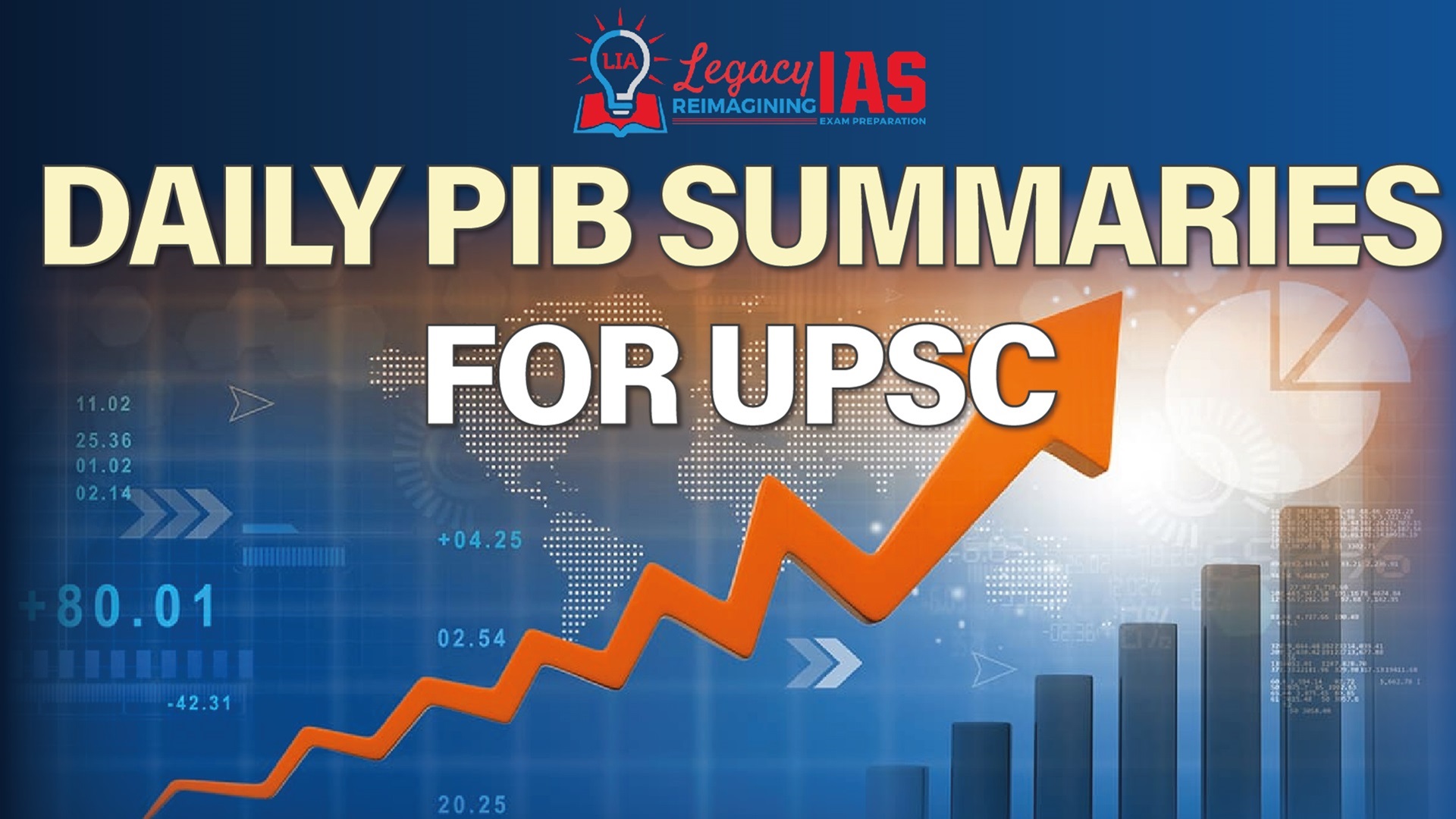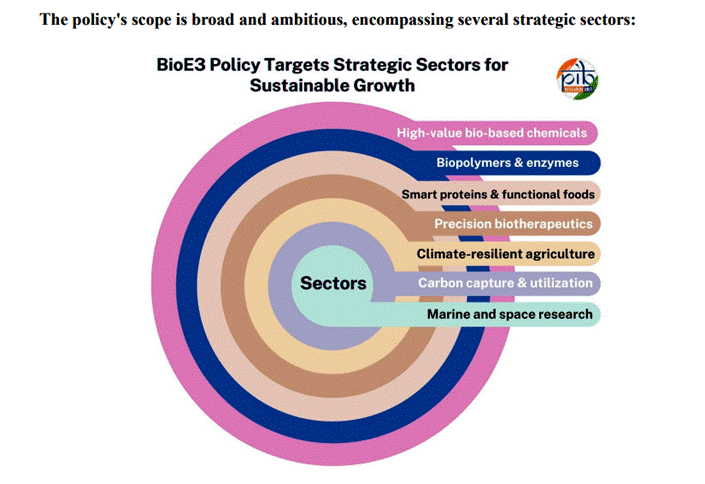Published on Sep 8, 2025
Daily PIB Summaries
PIB Summaries 08 September 2025

Content
- BioE3 Policy
- New GST rates will prove to be a boon for farmers
BioE3 Policy
Why in News
- On 6 September 2025, ICGEB New Delhi commemorated the first anniversary of the BioE3 Policy through the event BioE3@1.
- Theme: “Institute–Industry Interaction for Climate Resilient Agriculture and Clean Energy.”
- Objective: Accelerate lab-to-market translation of biotech innovations in agriculture, clean energy, and allied sectors.
Relevance : GS-3 (Science & Technology – biotechnology, bioeconomy, microbial biomanufacturing, bio-AI hubs, space-based biotech experiments), GS-3 (Economy – entrepreneurship, startups, commercialization, innovation-driven employment), GS-3 (Environment – climate-resilient agriculture, clean energy, sustainable practices, Net Zero 2070)

BioE3 Policy
- Full Form: Biotechnology for Economy, Environment & Employment.
- Approval: By Union Cabinet in August 2024.
- Purpose:
- Augment R&D and entrepreneurship in 6 thematic sectors.
- Accelerate technology development and commercialization via Biomanufacturing & Bio-AI hubs and the Biofoundry.
- Promote industrialization of biology for sustainable and circular practices.
- Address critical societal challenges: climate change mitigation, food security, human health.
- Core Objectives:
- Strengthen India’s bioeconomy.
- Support climate-resilient agriculture, clean energy, and biomanufacturing.
- Generate employment through innovation-driven biotech industries.
- Contribute to Net Zero carbon emissions by 2070.
Biofoundry & Technological Initiatives
- Biofoundry at ICGEB, New Delhi:
- Focus: Microbial biomanufacturing using bacteria and yeast platforms.
- Production capacity: up to 20 L scale, targeting higher Technology Readiness Level (TRL) for industry transfer.
- Operates on DBTL model – Design, Build, Test, Learn:
- Design: AI, bioinformatics, pathway analysis, host selection.
- Build: DNA assembly, organism transformation.
- Test: Screening, product analysis, pathway optimization.
- Learn: Machine learning-based outcome optimization.
- Applications: Food, agriculture, chemicals, drugs, energy sectors.
- Promotes: Innovation, startups, entrepreneurship, education, training, collaborations.
- Space-based Biotechnology Experiments:
- Microalgae: Chlorella sorokiniana-I, Parachlorella kessleri-I, Dysmorphococcus globosus-HI studied on ISS for microgravity, CO₂, O₂ impact.
- Cyanobacteria: Spirulina (Indian isolate) and Synechococcus strains tested for C and N recycling under microgravity.
- Applications:
- Earth: Value-added industrial products.
- Space: CO₂ capture, nutrient production, life support for astronauts.
BioE3 Policy Significance
- Policy-Industry Synergy:
- Strengthens industry-academia collaboration for commercialization of research.
- Event highlighted lab-to-market pathways in agri-biotech, clean energy, and microbial biomanufacturing.
- Technological Impact:
- Supports climate-resilient agriculture, renewable energy, and bio-based products.
- Biofoundry catalyzes microbial synthetic biology, metabolic engineering, and biomanufacturing innovations.
- Space-based biotech experiments expand India’s strategic biotech capabilities for future missions.
- Strategic & Economic Importance:
- Positions India as a global leader in bioeconomy and biomanufacturing.
- Aligns with sustainable development goals and national Net Zero 2070 commitment.
- Facilitates inclusive growth via innovation, entrepreneurship, startups, and education.
- Long-term Vision:
- BioE3 Policy represents a transformative framework anchoring biotechnology in economy, environment, and employment.
- Drives resilient, innovation-led growth, addressing societal and global sustainability challenges.
New GST rates will prove to be a boon for farmers
- Focus: Reduce the cost of agricultural inputs and equipment, boost farm income, and promote organic, bio-based, and integrated farming practices.
Relevance : GS-3 (Economy – GST reforms, reduced input costs, value addition, rural economy, GDP growth), GS-3 (Agriculture – organic, bio-based, integrated farming, modern equipment, efficient irrigation, allied sectors)
Key Details
- GST Reforms in Agriculture & Allied Sectors:
- GST on agricultural equipment reduced from 18% to 5% (tractors, harvesters, rotavators, power tillers, seed drills, planters, etc.).
- Bio-pesticides and micro-nutrients: GST reduced to encourage natural and organic farming.
- Dairy sector: No GST on milk, cheese, butter, ghee, and milk containers, benefiting farmers and milk producers.
- Fertilizers (raw materials like ammonia, sulphuric acid, nitric acid): GST reduced from 18% to 5%, lowering fertilizer costs.
- Processed fruits, vegetables, dry fruits, preserved fish, natural honey: GST reduction to boost value addition and income of farmers.
- Energy-based agricultural equipment and drip irrigation: GST reduced to 5%, encouraging efficient and sustainable farming.
- Cement and iron for rural infrastructure: GST reduction supports Pradhan Mantri Awas Yojana and rural development projects.
- Financial Impact on Farmers:
- Example savings on tractors:
- 35 HP: ₹41,000 saved
- 45 HP: ₹45,000 saved
- 50 HP: ₹53,000 saved
- 75 HP: ₹63,000 saved
- Savings extend to power tillers, planters, harvesters, and seed/fertilizer drills.
- Lowered GST reduces overall cost of production, increasing farmer profits.
- Example savings on tractors:
- Integrated Farming and Rural Benefits:
- Encourages allied sectors like animal husbandry, fish farming, beekeeping, agro-forestry, poultry, and sheep-goat rearing.
- Boosts women-led SHGs, handicrafts, dairy, and small-scale rural enterprises (“Lakhpati Didi” initiative).
Significance
- Economic Benefits:
- Reduced GST lowers input costs and enhances farmers’ net income.
- Increased demand for equipment, organic inputs, and processed farm products will strengthen rural economy and overall GDP.
- Agricultural Transformation:
- Promotes natural, organic, and integrated farming, reducing dependency on chemical inputs.
- Encourages modern farming techniques, efficient irrigation, and renewable energy adoption in agriculture.
- Rural Development and Infrastructure:
- GST reduction on cement and iron lowers construction costs for rural houses, schools, Panchayat Bhawans, Anganwadis, supporting infrastructure development.
- Sectoral Boost:
- Dairy, fisheries, and processed agricultural products will see higher production and market competitiveness.
- Allied rural sectors gain direct benefits from lower GST, promoting inclusive rural growth.
- Strategic Policy Impact:
- Supports Prime Minister’s vision of next-generation GST reforms.
- Facilitates integrated farming systems, linking crop production with livestock, fisheries, and agro-processing.
- Strengthens self-reliance and sustainability in the agricultural sector.
